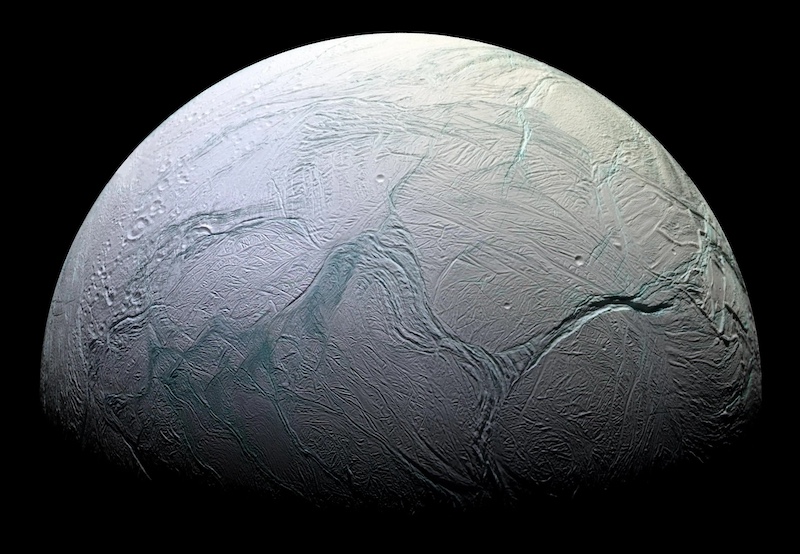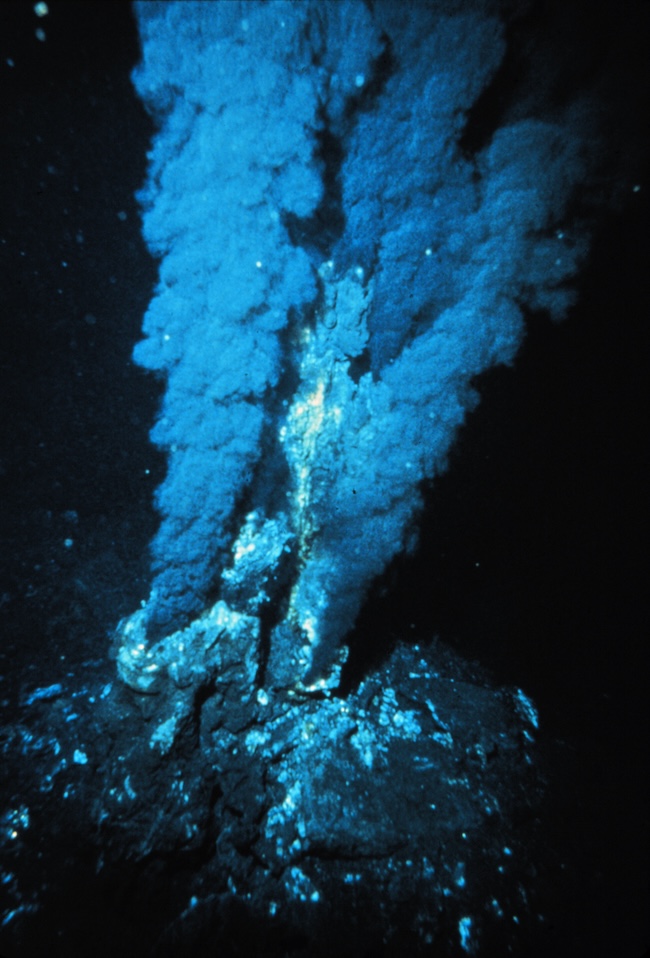
- Researchers at UC Santa Cruz led a new study of possible hydrothermal vents on the seafloors of ocean moons in our solar system.
- They simulated seafloor conditions on the moons by using models of hydrothermal activity in Earth’s oceans.
- The researchers found such hydrothermal activity could exist on ocean moons for millions to billions of years and possibly support life.
Hydrothermal vents on ocean moons could support life
Hydrothermal vents are geyser-like jets of geothermally heated water on the ocean floor. They can be an oasis for a wide variety of deep-sea life forms despite the surrounding cold temperatures and lack of sunlight. Scientists have wondered if hydrothermal vents could exist on ocean moons in our solar system, such as Europa and Enceladus. On June 24, 2024, researchers said hydrothermal vents could be sustained under a wide range of conditions. And they also said the vents could be capable of supporting life.
The journal JGR Planets published the new peer-reviewed findings on June 24, 2024.
Simulating hydrothermal vents on ocean moons
In order to determine whether hydrothermal vents could be occurring on any of the ocean moons, the researchers used a complex computer model. The model is based on hydrothermal circulation on Earth. This is basically the circulation of hot water in the ocean. The study focused on the 3.5 million-year-old seafloor in the northwestern Pacific Ocean, east of the Juan de Fuca Ridge. But ocean moons are not the same as Earth, even though they have lots of water. So the researchers had to take into account differences such as gravity, heat, rock properties and fluid-circulation depth.
The researchers found similar hydrothermal vents could indeed exist on ocean moons. They could even be sustained under a wide variety of conditions. They would be of relatively lower temperature, so not too hot for life to exist. The study results showed this hydrothermal activity could continue for millions to billions of years, possibly throughout the life of the solar system and long enough for life to start. As Andrew Fisher, the lead author from UC Santa Cruz, said:
This study suggests that low temperature (not too hot for life) hydrothermal systems could have been sustained on ocean worlds beyond Earth over timescales comparable to that required for life to take hold on Earth.

Hydrothermal circulation
In the seafloor environment used in the study, cool bottom water flows in through an extinct volcano with steep sides (also called a seamount). Then, it travels underground for about 30 miles (about 50 km) and flows back out into the ocean through another seamount. Co-author Kristin Dickerson at UC Santa Cruz noted:
The water gathers heat as it flows and comes out warmer than when it flowed in, and with very different chemistry.
Buoyancy enables the flow of hot water, called hydrothermal circulation, between the seamounts. This is due to water being less dense when it warms and more dense when it cools. So it creates differences in fluid pressure in the seafloor rock. As such, the system is self-sustaining. Fisher said:
We call it a hydrothermal siphon.
It’s even possible this kind of hydrothermal vent could be more likely on ocean moons than on Earth. Co-author Donna Blackman said:
Lower-temperature flows are at least as likely to occur, if not more likely.

Previous evidence for hydrothermal vents on Enceladus
There has, in fact, already been some previous evidence found for hydrothermal activity on Saturn’s moon Enceladus.
Earlier studies of data from NASA’s Cassini spacecraft showed the presence of both molecular hydrogen and silica in the water vapor plumes that originate from Enceladus’ subsurface ocean. Both are markers of hydrothermal activity on the ocean floor.
As Hunter Waite of the Southwest Research Institute (SwRI) and principal investigator of Cassini’s Ion Neutral Mass Spectrometer (INMS) said at the time:
The dynamic interface of a complex core and seawater could potentially create energy sources that might support life. While we have not found evidence of the presence of microbial life in the ocean of Enceladus, the growing evidence for chemical disequilibrium offers a tantalizing hint that habitable conditions could exist beneath the moon’s icy crust.
Even if there are hydrothermal vents on ocean moons, that doesn’t prove life is there. But it does add to a growing list of evidence for habitable conditions in at least some of these alien oceans. This includes Jupiter’s moon Europa in particular, which is now thought to also have possible hydrothermal vents.
Bottom line: A new study shows ocean moons in our solar system could have long-lasting geothermal activity on their oceans floors and may even be able to support life.
Source: Sustaining Hydrothermal Circulation With Gravity Relevant to Ocean Worlds
Read more: Enceladus’ ocean even more habitable than thought
Read more: Do Europa’s odd ridges indicate life?
The post Hydrothermal vents on ocean moons could support life first appeared on EarthSky.
from EarthSky https://ift.tt/l659nPk

- Researchers at UC Santa Cruz led a new study of possible hydrothermal vents on the seafloors of ocean moons in our solar system.
- They simulated seafloor conditions on the moons by using models of hydrothermal activity in Earth’s oceans.
- The researchers found such hydrothermal activity could exist on ocean moons for millions to billions of years and possibly support life.
Hydrothermal vents on ocean moons could support life
Hydrothermal vents are geyser-like jets of geothermally heated water on the ocean floor. They can be an oasis for a wide variety of deep-sea life forms despite the surrounding cold temperatures and lack of sunlight. Scientists have wondered if hydrothermal vents could exist on ocean moons in our solar system, such as Europa and Enceladus. On June 24, 2024, researchers said hydrothermal vents could be sustained under a wide range of conditions. And they also said the vents could be capable of supporting life.
The journal JGR Planets published the new peer-reviewed findings on June 24, 2024.
Simulating hydrothermal vents on ocean moons
In order to determine whether hydrothermal vents could be occurring on any of the ocean moons, the researchers used a complex computer model. The model is based on hydrothermal circulation on Earth. This is basically the circulation of hot water in the ocean. The study focused on the 3.5 million-year-old seafloor in the northwestern Pacific Ocean, east of the Juan de Fuca Ridge. But ocean moons are not the same as Earth, even though they have lots of water. So the researchers had to take into account differences such as gravity, heat, rock properties and fluid-circulation depth.
The researchers found similar hydrothermal vents could indeed exist on ocean moons. They could even be sustained under a wide variety of conditions. They would be of relatively lower temperature, so not too hot for life to exist. The study results showed this hydrothermal activity could continue for millions to billions of years, possibly throughout the life of the solar system and long enough for life to start. As Andrew Fisher, the lead author from UC Santa Cruz, said:
This study suggests that low temperature (not too hot for life) hydrothermal systems could have been sustained on ocean worlds beyond Earth over timescales comparable to that required for life to take hold on Earth.

Hydrothermal circulation
In the seafloor environment used in the study, cool bottom water flows in through an extinct volcano with steep sides (also called a seamount). Then, it travels underground for about 30 miles (about 50 km) and flows back out into the ocean through another seamount. Co-author Kristin Dickerson at UC Santa Cruz noted:
The water gathers heat as it flows and comes out warmer than when it flowed in, and with very different chemistry.
Buoyancy enables the flow of hot water, called hydrothermal circulation, between the seamounts. This is due to water being less dense when it warms and more dense when it cools. So it creates differences in fluid pressure in the seafloor rock. As such, the system is self-sustaining. Fisher said:
We call it a hydrothermal siphon.
It’s even possible this kind of hydrothermal vent could be more likely on ocean moons than on Earth. Co-author Donna Blackman said:
Lower-temperature flows are at least as likely to occur, if not more likely.

Previous evidence for hydrothermal vents on Enceladus
There has, in fact, already been some previous evidence found for hydrothermal activity on Saturn’s moon Enceladus.
Earlier studies of data from NASA’s Cassini spacecraft showed the presence of both molecular hydrogen and silica in the water vapor plumes that originate from Enceladus’ subsurface ocean. Both are markers of hydrothermal activity on the ocean floor.
As Hunter Waite of the Southwest Research Institute (SwRI) and principal investigator of Cassini’s Ion Neutral Mass Spectrometer (INMS) said at the time:
The dynamic interface of a complex core and seawater could potentially create energy sources that might support life. While we have not found evidence of the presence of microbial life in the ocean of Enceladus, the growing evidence for chemical disequilibrium offers a tantalizing hint that habitable conditions could exist beneath the moon’s icy crust.
Even if there are hydrothermal vents on ocean moons, that doesn’t prove life is there. But it does add to a growing list of evidence for habitable conditions in at least some of these alien oceans. This includes Jupiter’s moon Europa in particular, which is now thought to also have possible hydrothermal vents.
Bottom line: A new study shows ocean moons in our solar system could have long-lasting geothermal activity on their oceans floors and may even be able to support life.
Source: Sustaining Hydrothermal Circulation With Gravity Relevant to Ocean Worlds
Read more: Enceladus’ ocean even more habitable than thought
Read more: Do Europa’s odd ridges indicate life?
The post Hydrothermal vents on ocean moons could support life first appeared on EarthSky.
from EarthSky https://ift.tt/l659nPk

Aucun commentaire:
Enregistrer un commentaire